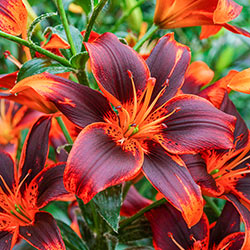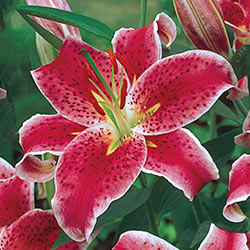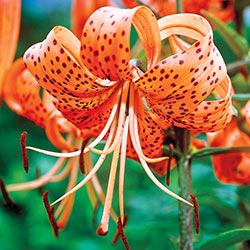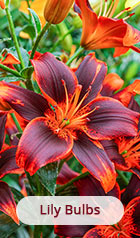
Gardening with Lilies
With showy blooms, a signature scent, and a rainbow of cultivar-specific color, it's easy to see why gardeners love growing lily bulbs. The Lilium genus contains all true lilies-large-flowered plants grown on tall spikes with pointed leaves. While other perennials, such as
daylilies or
calla lilies, have the word "lily" in their name, those flowers are not true lilies. The naming of other plants in reference to lilies shows just how important these plants are to gardening culture!
Lilium comes from the ancient Greek leírion, which refers to true white Madonna lilies. In Greek mythology, the lily is associated with Hera, the wife of Zeus. However, lilies appear throughout Roman, Chinese and Minoan mythology, as well as in the Old and New Testaments. Throughout the centuries, gardeners and admirers alike have marveled at the wide-open petals of lilies, in all their forms.
What Are the Different Types of Lilies?
Lilies are a hugely varied genus, so let's look at the types of lilies you may choose to plant in your garden. From classic Oriental lilies to unique Stargazer varieties, Michigan Bulb has everything beginning gardeners need for success!
While you'll find lots of variety across the lily universe, there are a few big groups you'll see again and again. Let's talk about the heavy hitters: Asiatic lilies, Oriental lilies, and hybrid lilies.

Asiatic lilies. A classic in the garden, the set of
Asiatic lilies grows in a rainbow of bright colors and unique variegations and striping. You'll see Asiatic lilies in whites, pastels, jewel tones, and even true bright colors! Asiatic lilies tend to bloom in early spring, and are available in both tall and dwarf varieties. Asiatics lilies have smaller blooms than Oriental lilies, and their petals feature smooth edges. Asiatic lilies are not noted for fragrance.

Oriental lilies. The divas of the lily garden,
Oriental lilies are known for their huge blooms and fragrant perfume. The sweet and spicy aroma of Oriental lilies smells just like a summer day! Oriental lilies include many of our beloved "big flower" varieties, including huge and magnificent
Stargazer lily varieties. Many Stargazers feature wide, striped petals in hues of pink, purple, white and red. These petals have ruffled edges, and sometimes feature attractive freckling. Oriental lilies grow taller than Asiatic lilies, and their flowers are bigger, too. They bloom in summer, with some varieties extending into fall.

Hybrid lilies. Since lilies are so well-loved, not to mention extremely easy to grow, gardeners have cultivated thousands of varieties of these beautiful perennials. Some just don't fit into another category, so you can think of these lilies simply as hybrids.These lilies feature the best of both the Asiatic and Oriental lily varieties. For example, our Tree Lilies are a cross between Asiatic and Oriental lilies, combining the best traits of both species into one tall plant with big color and sweet fragrance.
Tiger lilies, Easter lilies, and some of our favorite
giant lilies are hybridized for their specific color and shape. Hybrid lilies let you think outside the box, and try something totally different!
No matter your needs-white or colorful, dwarf or tall, subdued or bedazzling-you'll find a perfect, easy-to-grow lily. There's just so much that this genus has to offer!
How to Grow Lilies
Lilies are simple to grow, and, in most climates, they're happy to come back year after year. So, how do you start growing lilies? You'll need to consider placement, disease prevention, and general care and feeding. First, let's look at where to plant lily bulbs.
Where Should You Plant Lily Bulbs?
Lilies prefer locations with full sun, and it's imperative to plant your lilies in a location that drains well. As you choose a spot for your lily garden, consider the following:
- Soil drainage: Lilies don't like to have "wet feet," so choose a location that dries out quickly after rainfall, and isn't set in a low-lying part of your landscape. If you have very clay-heavy soil, you may need to amend your garden with loam or another drainage-friendly material.
- Soil acidity: To a new gardener, soil acidity can feel like a return to the chemistry classroom. However, most perennials-lilies included-prefer slightly acidic soil. That basically means that, if your soil is alkaline or clay-rich, you may need to add lime or fertilizer to acidify the soil a bit.
- Light: Lilies require at least six to eight hours of sunlight each day. With less sun, their stems may become floppy or spindly. So, choose a spot that receives plenty of light-direct is better than indirect, but indirect light will do for some varieties.
- Spacing: Make sure to give your flowers room to grow. Double-check their descriptions and consider both height and width when figuring out spacing, as these plants prefer not to be crowded. Since lilies naturally grow in clumps, consider planting a grouping together for a naturalized look.
Lilies are easy to grow, and don't require time-consuming winterizing like other summer-blooming plants. Give them the best start you can, and they'll definitely reward you!
When Are Lilies in Season?
Lilies are in season during the spring or summer, depending upon variety. Asiatic lilies, those smaller varieties with bright green leaves, tend to bloom in mid-spring. Oriental varieties wait until summer to bloom, opening in May, June, or July in most of the United States.
Of course, the season for lilies depends upon location. You may also ask, what are good climates for lilies? Most of the lilies offered by Michigan Bulb are cold-hardy in zones as low as zones 3 or 4, which are far north in the continental U.S. These flowers typically don't mind warm southern heat, although some varieties should get a bit of afternoon shade to avoid burning in the highest heats. That means that most of the United States offers a suitable climate for hybrid, Asiatic, and Oriental lilies!
How Do You Care for Lilies?
After choosing the right location and climate for your lilies, you'll find that they're fairly easy to grow throughout the seasons. Let's look at the type of care your lilies may require!
Staking: Asiatic lilies generally don't need to be staked, but large-flowered Oriental and hybrid lilies might require staking. If your lilies start to tip over, choose a stake at the grown height of the plant, and loop twine around the lily's head to hold it up. Pre-looped stakes are also a great choice for these plants. Growing lilies near shrubs or shorter perennials may help you hide their gangly legs.
Watering: In the spring, lilies like to receive at least an inch of water per week. During dry spells, keep up with watering using a soaker hose or simple watering can. Water near the base of the lily, not on the flowers.
Fertilizer: A light, balanced fertilizer may encourage blooming. A top dressing of manure or compost in the spring will do the job.
Deadheading and cleanup: Deadheading your lilies after they bloom will keep the plants looking clean. However, don't cut back the leaves of the lilies until they die back naturally. Allow your lilies to stay upright, so that the leaves can collect energy for the following blooming season.
End of Season Care for Lilies
How can you ensure that your lilies will come back year after year? Good end-of-season care is important. The most important thing to remember is to leave your leaves!
As tempting as it may be to trim back your lilies as soon as the leaves brown, you should allow them to continue to get sunlight and store energy in its bulb for the next season. Once the stalks have died back in the fall, go ahead and cut them all the way back to the ground.
Fall is the right time for dividing lilies, too. Every few years, you may find that your plants look crowded, or even that the bloom size has decreased. These are both signs that division may be necessary. Dig up your lily bulb, and look for new clumps forming along the main bulb. Pull off those new clumps, or divide your bulbs with a clean knife, before replanting them. If you need to divide your lilies by cutting, make sure each 'division' has several leaves and plenty of good roots.
Lilies are cold-hardy in most U.S. climates. While "cold-hardy" doesn't mean "evergreen," it does mean that these plants will come back year after year. However, some gardeners in very cold climates choose to lift their lily bulbs overwinter to protect them from wintertime damage. If you've planted lilies that are not cold-hardy in your zone, you should lift them out of the ground after the leaves have died back.
Use a spade in late fall to unearth your lily bulbs, and gently shake the dirt from them. Let your lily bulbs cure, or dry, for a few days in a cool and dark location. Then, store them in a breathable container to avoid mold or mildew setting in. Try using a cardboard box, paper bag, or container with peat moss between layers of paper. Wait until mid or late spring to replant your bulbs.
Pests and Diseases of Lilies
Just like any other plant, lilies do experience occasional issues with bugs and disease. Let's look at a few pests to watch for:
- Millipedes, grubs, and wireworms: Worms and millipedes can do damage to the roots of your lilies, and burrow into their bulbs. If these pests appear, look for treatments that can kill worms and larvae as well as grown bugs to apply to the soil near your lily plants.
- Red lily beetle: Bright red lily leaf beetles are striking but damaging. The adults feed on the leaves of lilies and the larvae tend to hatch on the undersides of the foliage. Neem oil or a chemical spray can treat lily leaf beetles.
- Aphids and lilies: Aphids, tiny green insects that feed on leaves, can become a problem in late spring as your lilies' buds are forming. If you spot aphids, use a strong jet of water to remove them from your plants.
- Gray mold: Gray mold causes a dark brown or black blight on flowers and leaves, often forming near "wounts" on the plant. To prevent gray mold, keep your lilies well-drained, and divide them as needed to keep good air circulation. Remove infected plants or plant parts when you spot any blighted material.
Lilies are unlikely to suffer from major issues, but a good rule of thumb is to keep them well-drained and well-watched, and to treat any issues as soon as they arise.
Helpful Tips for Growing Lily Bulbs
To recap, let's look at some of our favorite lily gardening tips and tricks. Plant your lilies as soon as you receive them, and don't transplant them within the first two years.
- Make sure to give your flowers room to grow, and check the height and width of your plants when determining spacing.
- Good drainage is key, so don't plant lilies in a location that retains lots of water.
- Plant shorter perennials or lilies in front of the garden, and taller Oriental varieties in back, to allow those large flowers to shine over the shorter plants.
- Choose several varieties of lilies to keep the flower show going from spring into fall!
Lilies are beautiful and rewarding plants, and with just a little help from you, they'll come back year after year! To get started, visit our lilies category page and start dreaming.
Have another question? Return to the Customer Service Help page or send an e-mail directly to Customer Service

























